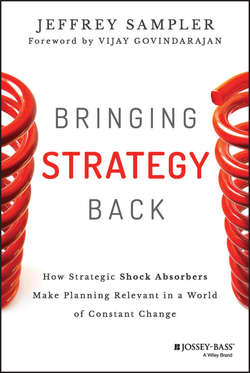Читать книгу Bringing Strategy Back - Jeffrey L. Sampler - Страница 2
На сайте Литреса книга снята с продажи.
The Jossey-Bass Business & Management Series
Foreword
ОглавлениеHistorically, innovations have originated in rich developed countries in the West and later flowed downhill to the populous developing world. But it is also possible for innovations to originate in poor countries and trickle up to the wealthier world. This is what I've termed reverse innovation.
I initially became interested in reverse innovation during a two-year stint as Professor in Residence and Chief Innovation Consultant at General Electric. At the time, GE CEO Jeff Immelt had put a stake in the ground to grow the company organically by meeting the needs and budgets of customers in heavily populated developing markets. As part of that plan, GE went on to introduce revolutionary new product adaptations – a $1,000 handheld electrocardiogram device and a portable, PC-based ultrasound machine that sells for as little as $15,000 – created to serve rural India and China. By developing lower-cost end-user solutions, GE has been able to cultivate an entirely new market. Just as notably, these innovations have since been adapted and sold in the United States and Europe.
It's clear that if rich nations and established multinationals are to continue to thrive, the current generation of innovators must look beyond their own backyard and consider the needs and opportunities in the vast developing world. And the idea of reverse innovation extends well beyond just product creation. For starters, we see pockets of reverse process innovation springing up as well. Hospitals in India, for example, are transforming health care by performing open-heart surgery for $3,000 rather than the $150,000 we see in the United States – and not simply because of lower labor costs, but also because they have adapted standardized processes from assembly-line manufacturing to make the procedure far more cost effective. This type of innovation would be possible anywhere, but it's more probable in poor countries because it meets their needs and requirements.
The reality is that the future of growth and innovation is far from home – in places like Asia, the Middle East, and elsewhere.
Reverse innovation is any innovation that is adopted first in the developing world. This includes management innovation, a subject that Jeffrey Sampler knows extremely well. What he's done in this excellent book is bring my work on reverse innovation together with Gary Hamel's idea of management innovation to create a new model for understanding and using the latest and greatest management innovations from places as far away as India and Dubai. Economies such as these are radically different from mature Western economies, and they have radically different needs. Therefore, their solutions must be radically different. Based on the author's vast research and experience working with executives at companies across these markets, the “Strategic Shock Absorbers” introduced here form a tool kit of management innovation that was developed because the pace of growth and change in India and Dubai was so intense that the Western management ideas simply did not apply.
The tools and advice here present an opportunity, and a solution, for Western multinationals that are not only struggling with the ever-increasing pace of change at home but also looking for ways to compete with incumbents in developing markets. The companies featured, such as Arvind Mills, Dabur, Future Group, DLF, or Network18, may be unfamiliar but they have succeeded because of, not despite, the seismic shifts that have occurred in the Indian economy over the past decade. They have made the most of change and Jeff Sampler makes a compelling case that they set the standard in terms of innovative management practices that serve not only to hedge against risks and but also ride the ongoing wave of change and disruption that is common in developing economies.
The stakes are enormous for adopting the type of reverse innovations of management ideas described here. Today, rich countries and poor countries account for roughly equal shares of the global economy. But for years, growth has been far more robust in poor countries. Increasingly, understanding how success happens there is a prerequisite to continued vitality at home. In the transformed economic landscape, reverse innovation – including the management innovations featured in this book – is not optional in any market.
Vijay Govindarajan
Coxe Distinguished Professor
Tuck School of Business
Dartmouth College
